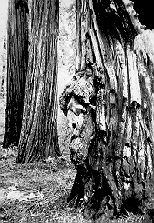
Coast redwoods have many amazing qualities. These trees would not be able to live as long as they do, or grow as tall as they do without some very special adaptations. The things that often kill other trees seem to have less severe effects on coast redwoods.
How are the redwoods able to survive fires, floods, diseases and insects? The answer to that question will give you a new appreciation for the complexity of nature and the wonders of the forest.
Before people settled here in the redwood region and began clearing land for homesteads, fires were a natural part of the cycle. Every quarter century or so, a big fire would burn some sections of the forest. These fires were beneficial to the forests for several reasons. First, fire cleared out the understory. Fire burned away all the built up debris on the forest floor and allowed sunlight to reach the ground. The increased sunlight on the forest floor created an opportunity for other plants to grow - plants which provided food for the Native Americans and shelter for wildlife. This cleared ground also gave redwood seeds a place to grow. Since approximately 90% of all redwood seeds are killed by fungus before they ever sprout, having a cleared place to grow increases the chances of survival of the seeds.
Second, fire leaves ash, which contains a high concentration of minerals and nutrients that are leached into the soil by the rain. These nutrients help other plants grow.
Fire also hollows out the inside of many trees, leaving behind cavernous holes. This does not kill the tree, since the major part burned is the heartwood, the dead wood inside a tree. The only living part of the wood is the cambium, a thin layer between the bark and the heartwood where all growth takes place. This is why trees have growth rings. Each year, a new layer of cells grows and produces a growth ring. Redwood bark is thick, up to 12 inches on some older trees. This thick bark is resistant to fire. Repeated fires however, can weaken the bark and get inside to the heartwood, where it can smolder for weeks and hollow out the tree. Tannin in the bark helps redwood trees resist insects and diseases.
The hollowed-out redwoods were useful to the settlers. They called these hollow trees "goosepens" and kept their chickens and geese in them. These trees sometimes served as shelters for people as well. The Hermit Tree in Humboldt Redwoods State Park is a famous tree known to have been used as a home. The hermit built a three- story dwelling inside a hollow tree. Unfortunately, this famous tree was burned by arsonists a few years ago.
Fire has another benefit to the coast redwoods. These trees are able to sprout new trunks from tissue in their root collars called burl. Burl is bud tissue which remains dormant until some kind of damage occurs to the trunk of the parent tree. When the parent tree is damaged, the burl tissue begins to grow. A tree that has lost its top due to wind can grow a new top in this way. Redwoods also sprout from the base, much the same way as rose bushes grow suckers. When the trunk is cut off, such as when a tree is logged or burned by fire, the tree will often develop a ring of sprouts around the stump. In areas that were logged many years ago, you can find these rings of trees, called "fairy rings" or "fire rings."
Burls not only occur only at the base of the tree, but can grow anywhere on the tree. In the picture below, the strange growth on the side of the tree is a burl. You may have seen redwood trees with two trunks. Redwoods are able to grow two trunks on the same tree when damage has occurred, and burl tissue starts growing.

Often, burls will have root sprouts growing downward from their bases. The ability to sprout new roots helps these trees survive floods. Flood waters deposit silt around the bases of the trees, smothering most trees. Redwoods however, can grow new roots into the newly deposited soil, enabling the tree to survive.
Since so many seeds die before germinating, sprouting is an important method of reproduction for redwoods.
Sprouting has another benefit. It helps fire ecologists determine the dates that fires occurred, because many trees begin growing sprouts after a fire. These sprouts can be used to determine the date of the fire. A core is taken from the tree and the rings are counted to determine the age of the sprout. The scientist does this to all sprouts in an area, determining the extent of the fire by the locations of the sprouts.
This information is used by fire ecologists and park managers, who determine the historical frequency of fires. They can then make decisions about how to re-introduce fire into the system.
Return to Humboldt Redwoods State Park Home Page.
